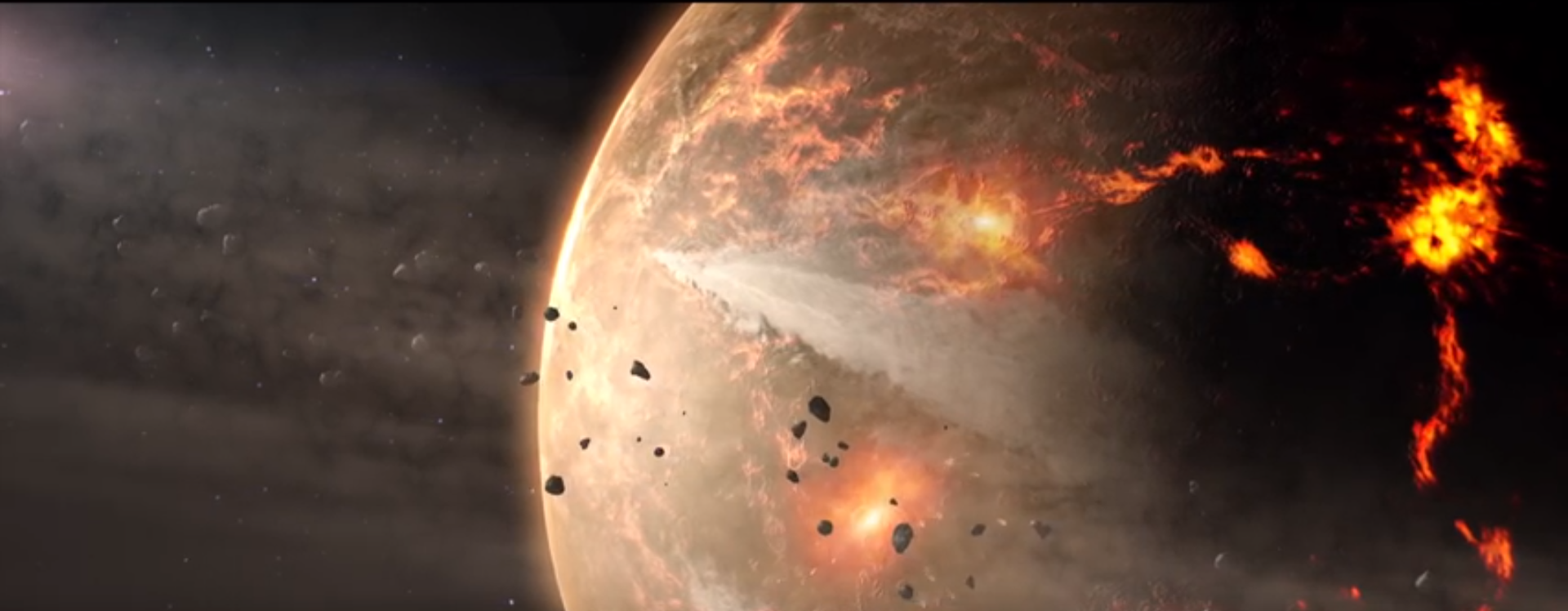
Artist’s depiction of extraterrestrial impactors of the late heavy bombardment striking Earth, perhaps the most significant origin-of-life frustration event. Image Credit: NASA’s Goddard Space Flight Center Conceptual Image Lab
In order to understand how the requirements for life might have first been met, origin-of-life (OOL) scientists must determine the chemicals, conditions, and time(s) available to meet first-life’s requirements. Nucleosynthesis of hydrogen and helium began minutes after the Big Bang, then elements of increasing mass developed over time in burning stars and through supernova events. The formation of hydrogen, carbon, nitrogen, oxygen, sulfur, and phosphorous are of particular interest since they are the elemental constituents of peptides, nucleotides, and phospholipids;1 these polymers are the organic precursors to proteins, nucleic acids, and cell membranes.2 “Chemical evolution and planetary evolution are [therefore] inextricably intertwined,” according to Alan Schwartz and Sherwood Chang.,3
Life-essential elements, prebiotic compounds, and even organic molecules, occur in interstellar space,4,5 comets,6 meteorites,7 asteroids, planets, and moons.8 Schwartz and Chang thereby assert that “organic matter occurs throughout the Universe as an integral component of cosmic evolution…[T]he prospect of identifying other life-harboring solar systems seems inevitable.”9 OOL researchers must yet determine how closely the prevalence of life directly corresponds to the proper abundances of necessary reagents, catalysts, and energies.
More specifically, Earth’s history and formation as part of the larger solar system must be considered in order to assess the plausibility of proposed OOL scenarios. The presence of interstellar organics might be thought to seed and speed Earth’s chemical evolution process; however, a steady pummeling of high-energy impactors during the Hadean Era, Moon-forming event, and late heavy bombardment (LBH) would have likely destroyed complex molecules, vaporized surface water, and significantly altered atmospheric conditions.
At this point, it should be noted that an inadequately founded assumption regarding the composition of the early atmosphere reduced (pun intended) the Miller-Urey proof-of-principle experiment from a milestone to a mile marker on the road to first-life. But during the OOL’s “greatest frustration event,” the LBH, impact collisions produced a hot, molten surface that would deter the formation of a permanent land and ocean features until about 3.85 billion years ago.10,11 Fossil and geochemical data indicate that earliest life dates back to 3.7 billion years ago (bya), perhaps to 3.8+ bya.12 The plausible window of opportunity for elaborate chemical pathways to produce Earth’s first life closes, nearly shut. “Origin-of-life researchers [now] recognize that life had no more than tens of millions of years to emerge”13 – a far different scenario that what could have ever been imagined by earlier scientists who accepted a steady-state model of the universe. A rapidly increasing understanding of how cosmological events impacted (pun intended) the early Earth is reshaping OOL models. Those seeking purely naturalistic scenarios find that life is hard and its origin frustrated.
1 William J. Schopf, ed., Life’s Origin: The Beginnings of Biological Evolution (Berkeley, CA: University of California Press, 2002), 33.
2 Ibid, 46.
3 Ibid.
4 Ibid, 51.
5 Ibid, 52.
6 Ibid, 59.
7 Ibid, 62.
8 Ibid, 47.
9 Ibid.
10 Fazale Rana and Hugh Ross, Origins of Life: Biblical and Evolutionary Models Face Off (Covina, CA: Reasons to Believe, 2014), 63.
11 Ibid, 88.
12 Ibid, 75.
13 Ibid, 27.